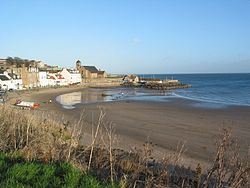Kinghorn
| Kinghorn | |
| Fife | |
|---|---|
 Across Kinghorn Harbour | |
| Location | |
| Grid reference: | NT271869 |
| Location: | 56°4’12"N, 3°10’12"W |
| Data | |
| Population: | 2,930 (2008 est.) |
| Post town: | Burntisland |
| Postcode: | KY3 |
| Dialling code: | 01592 |
| Local Government | |
| Council: | Fife |
| Parliamentary constituency: |
Kirkcaldy and Cowdenbeath |
Kinghorn is a seaside resort town and royal burgh in Fife. It has two beaches, Kinghorn Beach and Pettycur Bay, plus a fishing port. It stands on the north shore of the Firth of Forth, opposite Edinburgh. According to the 2008 population estimate, the town has a population of 2,930.
Known as the place where King Alexander III died, it lies on the A921 road and the Fife Coastal Path. Kinghorn railway station is on the Edinburgh to Aberdeen and Fife Circle railway lines. Kinghorn only has a primary school so older pupils travel to Kirkcaldy.
The town's lifeboat station is one of the busiest on this coast, regularly getting called out to all sorts of emergencies in the Firth. Currently stationed at Kinghorn is an Atlantic 85 inshore lifeboat, B-836 "Tommy Niven".
Name
The name Kinghorn was locally pronounced Kin-gorn with stress on the latter syllable until at least the early twentieth century. It derives from the Gaelic ceann gronn menaing "head of the bog'".[1]
History
The historic former Royal Burgh of Kinghorn once had a castle frequently visited by the Scottish Court in the period of the House of Dunkeld. The King's castle, controlling the sea way, stood on the headland above Pettycur. A later structure, Glamis Tower, stood just behind the High Street. Both buildings have totally disappeared and the sites built over in modern times.
While King Alexander III was returning to Kinghorn to see his new wife that he fell from his horse on the ride from Burntisland and was found dead on the beach of Pettycur Bay.
During the Reformation, French troops commanded by Henri Cleutin and Captain Sarlabous sailed from Leith and fought with the Lords of the Congregation at Pettycur Bay on 7 January 1560. Kinghorn castle remained an important possession of the Scottish crown, and this was recognised by the creation of the Earldom of Kinghorne in 1606.
A burn fed from the freshwater Kinghorn Loch above the town once provided the town with its water and subsequently provided the source of power to drive the machinery of flax mills.
The old town was dramatically transformed in 1846 by the construction of the railway viaduct across the valley of the burn and the opening of Kinghorn Station by the Edinburgh and Northern Railway which had its terminus at Burntisland for ferries across the Forth to Granton. Much of the former horse ferry traffic from Pettycur bay was lost to Burntisland.
Following the opening of the Forth Railway Bridge in 1890,the North British Railway started to promote Kinghorn's picturesque sheltered bay and beach as a resort which led to considerable development of the town.
Culture and sport
An annual attraction is the Black Rock '5' Race, commonly referred to as the "Black Rock '5'" or the "Black Rock Race" is a road and beach running race of about 4½ miles that has been held each year in Kinghorn since 1987. Its distinguishing feature is the loop around the Black Rocks, over a mile from the shore, and largely under water except at low tide. The race is held on a suitable Friday in May or June, when the tide is out and the water is no more than knee deep. Over these past 19 years it has changed from a simple race, into a full-blown social night on Kinghorn's calendar. There is also a shorter Midi Black Rock Race.
The inaugural Black Rock '5', held in 1987, was won by Gifford Kerr, ahead of 66 other finishers; a very small field by today's standards - in 2005 there were over 600 participants, of a wide variety of abilities. The race has been staged every year since 1987, apart from 1991, and throughout the 90's the numbers have increased significantly, as did the quality of the top end of the field, with winners including Bobby Quinn and Terry Mitchell. The new millennium has witnessed domination by Hunters Bog Trotters (HBT) with both Phil Mowbray and Don Naylor having taken the spoils. The course record belongs to Ian Harkness, also of HBT, in a time of 22:03.
Outside links
- Kinghorn lifeboat
- Black Rock race
- Old and New Kinghorn pictures on Fife Family History
- [1]/ Alexander Carrick], sculptor of the war memorial
References
- ↑ Taylor, Simon; Gilbert Markus (2006). The Place-Names of Fife, Volume One. Shaun Tyas. pp. 416–7. ISBN 1-900289-77-6.